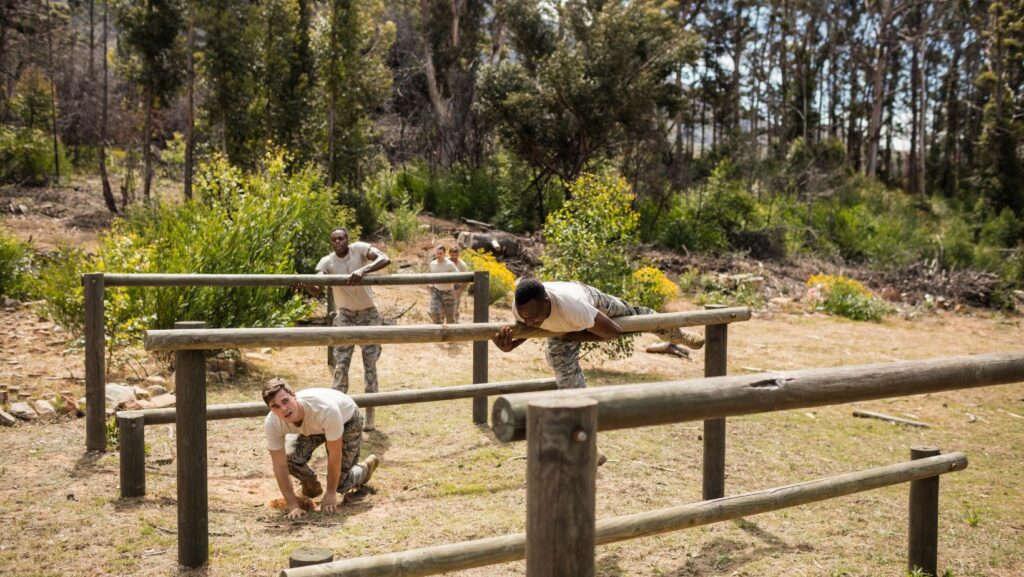Military Fitness Training
Military fitness training emphasizes a disciplined and systematic approach that combines physical and mental preparation. It incorporates diverse exercise routines including strength training, cardio, flexibility, and high-intensity interval training (HIIT). These elements simulate real-life combat situations, promoting functional fitness necessary for military operations.
Trainers customize regimens to match the specific demands of each military branch, such as the Army or Navy. Soldiers engage in obstacle courses, road marches, and team-based drills, forging resilience and adaptability. Consistency in training ensures swift decision-making and stress management under pressure.
Nutritional intake plays a crucial role, providing the energy needed for intense workouts. Military personnel follow well-balanced diets rich in proteins, carbohydrates, and essential fats. Hydration and rest are key, as they support recovery and prevent injuries.
Aspiring recruits and fitness enthusiasts adopt military fitness programs for their structured routines and measurable outcomes. These programs often include timed exercises, testing individuals’ endurance and focus. Incorporating military fitness principles can enhance overall health, performance, and mental toughness.
Military fitness involves critical components essential to building a well-rounded physical foundation. Strength, conditioning, cardiovascular endurance, flexibility, and mobility form the core elements of this training.
Strength and conditioning focus on developing muscle power and endurance. Training involves compound exercises such as squats, deadlifts, and bench presses. These movements build core strength, improving overall stability and performance. Trainers incorporate bodyweight exercises like push-ups and pull-ups to enhance muscular endurance.
Cardiovascular endurance boosts stamina, enabling sustained physical activity. Activities like running, swimming, and cycling are key components. HIIT workouts simulate the demands of a battlefield, sharpening the body’s ability to recover quickly. Program variation challenges the cardiovascular system and prevents plateaus.
Flexibility and mobility enhance movement efficiency and reduce injury risk. Dynamic stretches and yoga improve joint health and muscle elasticity. Training balances strength gains with range of motion improvements, ensuring soldiers can perform diverse physical tasks efficiently. Enhanced mobility prepares individuals for complex maneuvers and rapid adaptability.
Benefits of Military Fitness Training
Military fitness training provides numerous advantages, impacting both physical and mental aspects. Participants can see notable improvements across various fitness dimensions. Engaging in military fitness training boosts physical health by enhancing cardiovascular endurance, muscular strength, and flexibility. These exercises typically incorporate intense workouts, combining strength and cardiovascular routines like running and circuit training that improve heart health and overall stamina.  Training regimens often include bodyweight exercises and resistance training, leading to increased muscle mass and improved functional strength, crucial for carrying heavy loads and performing rigorous tasks. The diverse movements involved in these routines enhance flexibility and mobility, reducing injury risk and enabling more fluid motion.
Training regimens often include bodyweight exercises and resistance training, leading to increased muscle mass and improved functional strength, crucial for carrying heavy loads and performing rigorous tasks. The diverse movements involved in these routines enhance flexibility and mobility, reducing injury risk and enabling more fluid motion.
Aside from physical benefits, military fitness training develops mental resilience and discipline through challenging environments that simulate real-world stressors. Participants build mental toughness by pushing through physically demanding exercises, leading to an improved ability to cope with stress. Military workouts often require a high level of focus and concentration, fostering discipline and time management skills. Achieving training goals encourages a mindset oriented towards perseverance, fostering a strong work ethic and a goal-focused mentality that extends beyond the workout arena into daily life.
Training Programs and Techniques
Military fitness training incorporates a range of structured programs and techniques that build physical and mental capabilities. These methods draw on traditional military workouts to foster strength, endurance, and adaptability. Boot camp-style workouts engage participants in intense, regimented exercise routines. These sessions typically last 45-60 minutes, combining strength and cardio drills to increase physical endurance. Activities include push-ups, burpees, and running. Groups perform exercises in unison, promoting teamwork and accountability. Boot camp workouts scale in difficulty, catering to both newcomers and experienced individuals. This format mirrors military basic training, designed to challenge participants and push them beyond their perceived limits.
These sessions typically last 45-60 minutes, combining strength and cardio drills to increase physical endurance. Activities include push-ups, burpees, and running. Groups perform exercises in unison, promoting teamwork and accountability. Boot camp workouts scale in difficulty, catering to both newcomers and experienced individuals. This format mirrors military basic training, designed to challenge participants and push them beyond their perceived limits.
Functional fitness exercises emulate real-world tasks requiring strength and coordination. These exercises incorporate compound movements such as lunges, kettlebell swings, and climbing drills. They improve balance, flexibility, and overall body awareness, essential for on-field performance. Functional exercises focus on enhancing one’s ability to perform daily activities with greater ease and efficiency. Military training prioritizes these exercises to ensure practical readiness for combat scenarios. Participants benefit from increased functional strength, reducing injury risks and bolstering operational efficiency.

